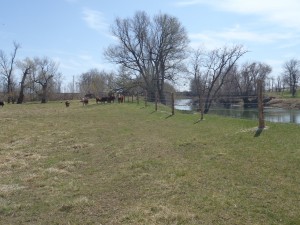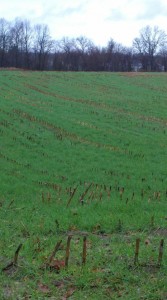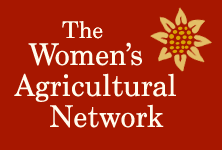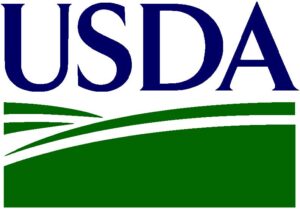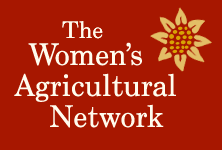Protecting water quality is everyone’s job; it just so happens it’s also my day job. As farmers, we manage a multitude of tasks on a daily basis. The To Do List always seems to get longer, not shorter. Have you ever walked out the door, a general plan for the day in place, and found yourself doing what I call ‘spinning’? You wander from unfinished task to unfinished task and finally sit down and profess, “I just don’t know where to start.” That happens to the best of us. As I work with Vermont farmers, I am always amazed by how many details they keep straight…in their heads, on scraps of paper, in their cell phones and otherwise. As a UVM Extension Agronomy Outreach Professional tasked with assisting farmers implement practices to protect water quality in Lake Champlain, I only add to that list of details. I show up in farmers’ fields and barns and ask them about Best Management Practices (BMPs) and how they protect water quality. I ask them about crop rotations, how much manure or fertilizer they have spread on a particular field, and how they maintain buffers to comply with our state’s Accepted Agricultural Practices. And there is ALWAYS records to keep and forms to sign and submit.
We are working together to get the job done. Vermont farms are in a very challenging position. Well managed farmland is a vital resource for our State and can benefit water quality. That said, farming has been identified by the Lake Champlain Basin Program and the EPA as a major contributor (along with waste water treatment facilities, urban stormwater runoff and forestry). The main farm pollutants are eroding soil and nutrients, as well as pathogens, pesticides, metals and salts. Not all farms do contribute to water pollution, however all farms have the potential to contribute to water pollution.
A short list of things you can do on your farm to protect water quality:
- Properly manage nutrient applications. Whether you’re spreading compost, manure, or fertilizer on a field; there is always the potential to over apply nutrients. Excess nutrients not utilized by the plants leave the soil eventually, some quicker than others. Test your soil and your manure/compost, and take note of the those numbers on your on the fertilizer bag. Once you know what’s already in your soil and what your amendments are contributing, you can do some quick math to accurately apply what your crop needs without overdoing it. You might also save yourself some time and money!! Take it to the next level and create a formal Nutrient Management Plan for your farm.
- Incorporation. Not your business, but your nutrients! By incorporating your manure, compost and fertilizer into the soil immediately (or as soon as possible); you can considerably reduce nutrient losses. Depending on the situation, there are many methods to incorporate nutrient applications, all of which can help you maximize nutrient retention and reduce unnecessary runoff. These include tillage, aeration, and injection.
- Rotate your crops. You already know the benefits of crop rotation to insect and disease prevention and overall plant health. Rotation can benefit water quality as well. By alternating annual and perennial crops, you can significantly reduce erosion during perennial crop years. Rotating with grasses and non-legumes can contribute to valuable organic matter. Using legumes can provide nitrogen for future crops.
- Exclude livestock from surface water. When livestock have direct access to
surface water, there are many ways they can create pollution. They deposit manure directly in the water and erode stream banks. Fence animals out of creeks and streams, create dedicated livestock crossings through waterways, and develop alternative drinking water sources.
- Manage pastures for healthy plants (& animals). Overgrazing is problematic in many ways. In terms of water quality, overgrazed pastures experience more erosion, utilize less nutrients for plant growth, experience more compaction and runoff than well-managed pastures. Manage your pasture as a crop.
- Locate your manure and compost stacking sites appropriately. An improperly placed manure or compost pile can leach and/or runoff significant nutrients. Have you walked by your compost pile or manure pile and seen that blackish looking water? Those are ‘nutrients in solution’ headed downstream or into the groundwater. Not only are you potentially contributing to poor water quality, you are ‘flushing’ those nutrients you plan to use down the drain.
- Abide by buffers and setbacks. Depending on the size of your farm, and especially if you own livestock, buffers and setback minimums range from 10 to 25 feet (and more for drinking water wells). That means no tillage or manure applications in these areas. Better yet, leave grass long and plant woody trees and shrubs in these critical areas to substantially combat erosion and runoff.
- Conservation Tillage. By limiting your conventional tillage (or eliminating it), you can impact water quality immensely. Low till and no till systems conserve and build organic matter, increase soil biology, reduce erosion. Factor in labor and fuel savings and these practices become really worth considering!!
- Plant cover crops! Cover crops are a great way to get double duty out of a BMP, and
your possibilities are endless. Cover crops can provide many benefits. They ‘mop up’ excess nutrients in the soil at the end of a crop season; fix atmospheric nitrogen for future crop; out-compete and suppress weeds, contribute organic matter to improve soil structure & health, reduce erosion in winter and spring (and during summer for that matter); you can harvest or graze them too! The list could continue, but you get the idea.
- Timing is everything. Like everything in farming, protecting water quality is all about when, where and why. Applying fertilizer on tilled ground right before a rainstorm without incorporation is a recipe for nutrient-laden runoff.
As you can see, there are a lot of things we can do to benefit water quality on Vermont farms. Luckily there are a multitude of resources to help us get the job done. Here are just a few:
- UVM Extension-Champlain Valley Crop, Soil & Pasture program
- UVM Extension-Northwest Crops & Soils program
- USDA-Natural Resource Conservation Service
- Cost Share for BMPs from Vermont Agency of Agriculture
- A great explanation of the Accepted Agriculture Practices from VACD
- UVM Extension’s Agronomy Conservation Assistance Program (ACAP)
- UVM’s Agriculture Testing Lab
- Nutrient Management Planning Resources from UVM
- EPA Factsheet: Protecting Water Quality from Agricultural Runoff
- ATTRA Publication: Protecting Water Quality on Organic Farms
For more information, you can contact Kirsten Workman at (802) 388-4969 x347 or kirsten.workman@uvm.edu


